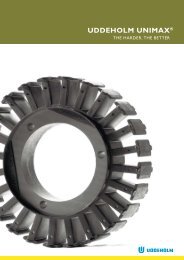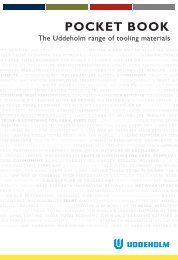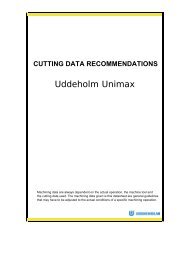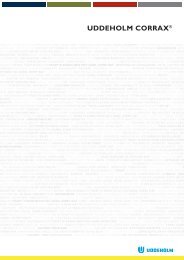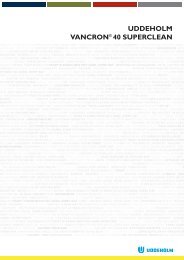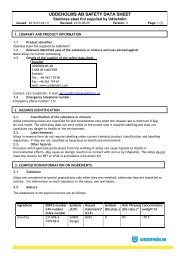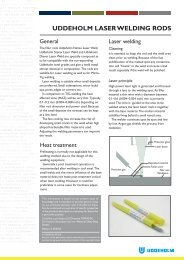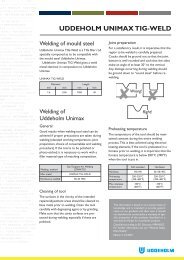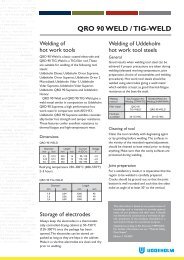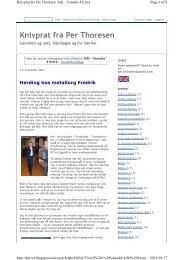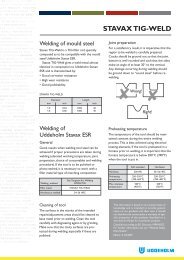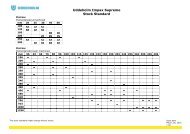Impax Supreme eng-110401/1109 - Uddeholm
Impax Supreme eng-110401/1109 - Uddeholm
Impax Supreme eng-110401/1109 - Uddeholm
Create successful ePaper yourself
Turn your PDF publications into a flip-book with our unique Google optimized e-Paper software.
UDDEHOLM IMPAX ® SUPREME
UDDEHOLM IMPAX SUPREME<br />
<strong>Uddeholm</strong> <strong>Impax</strong> <strong>Supreme</strong> is a premium prehardened mould steel with<br />
very good polishing and texturing properties.<br />
<strong>Uddeholm</strong> <strong>Impax</strong> <strong>Supreme</strong> is available in a very wide dimensional range,<br />
where even the largest dimensions show a very uniform hardness profile<br />
all through the cross section.<br />
The delivery hardness of ~310 HB, makes the steel suitable for a many<br />
different applications like:<br />
– Moulds for plastic injection moulding<br />
– Moulds for blow moulding<br />
– Dies for plastic extrusion<br />
– General constructional parts, like machine components requiring<br />
improved fatigue str<strong>eng</strong>th and reliability<br />
This information is based on our present state of knowledge and is intended to provide general<br />
notes on our products and their uses. It should not therefore be construed as a warranty of<br />
specific properties of the products described or a warranty for fitness for a particular purpose.<br />
Classified according to EU Directive 1999/45/EC<br />
For further information see our “Material Safety Data Sheets”.<br />
Edition 7, 09.2011<br />
The latest revised edition of this brochure is the English version,<br />
which is always published on our web site www.uddeholm.com<br />
SS-EN ISO 9001<br />
SS-EN ISO 14001
UDDEHOLM IMPAX SUPREME<br />
General<br />
<strong>Uddeholm</strong> <strong>Impax</strong> <strong>Supreme</strong> is a premiumquality<br />
vacuum-degassed Cr-Ni-Mo-alloyed<br />
steel which is supplied in the hardened and<br />
tempered condition, offering the following<br />
benefits:<br />
• No hardening risks<br />
• No hardening costs<br />
• Time saving, e.g. no waiting for heat<br />
treatment<br />
•Lower tool cost (e.g. no distortion to rectify)<br />
•Modifications easily carried out<br />
• Can be subsequently nitrided to increase<br />
surface wear resistance or locally flame<br />
hardened to reduce surface damage<br />
<strong>Uddeholm</strong> <strong>Impax</strong> <strong>Supreme</strong> is manufactured to<br />
consistently high quality standards with a very<br />
low sulphur content, giving a steel with the<br />
following characteristics:<br />
•Good polishing and photo-etching properties<br />
•Good machinability<br />
• High purity and good homogeneity<br />
• Uniform hardness<br />
Note: <strong>Uddeholm</strong> <strong>Impax</strong> <strong>Supreme</strong> is 100%<br />
ultrasonic tested.<br />
Heavier sections are supplied premachined<br />
which offers the following advantages compared<br />
with un-machined material:<br />
•Saving of weight<br />
• Non-decarburized surface<br />
• Exact nominal size (plus tolerance)<br />
• Less machining<br />
• Absence of scale minimizes machine and<br />
tool wear<br />
Approx.<br />
analysis %<br />
Standard<br />
spec.<br />
Delivery<br />
condition<br />
Colour code<br />
AISI P20 modified<br />
Applications<br />
C Si Mn Cr Ni Mo S<br />
0.37 0.3 1.4 2.0 1.0 0.2
UDDEHOLM IMPAX SUPREME<br />
TENSILE STRENGTH<br />
Approx. values. Samples were taken from a flat<br />
bar, 90 x 300 mm (3.5" x 11.8").<br />
Hardness: 325 HB.<br />
Testing temperature 20°C 200°C<br />
(68°F) (390°F)<br />
Ultimate tensile str<strong>eng</strong>th<br />
Rm N/mm 2 1020 930<br />
Yield str<strong>eng</strong>th<br />
Rp0.2 N/mm 2 900 800<br />
COMPRESSIVE STRENGTH<br />
Compressive<br />
yield str<strong>eng</strong>th Rc0.2 N/mm 2 850–1000<br />
Heat treatment<br />
<strong>Uddeholm</strong> <strong>Impax</strong> <strong>Supreme</strong> is intended for use<br />
in the hardened and tempered condition, i.e.<br />
the delivery condition.<br />
When, however, the steel is to be heat<br />
treated to a higher hardness or case hardened,<br />
the following instructions may be helpful.<br />
Quenching media<br />
• High speed gas/circulating atmosphere<br />
(Only suitable for small dimensions)<br />
• Oil (60–80°C/140–175°F)<br />
• Martempering bath 300°C (570°F)<br />
max. 4 minutes, then air<br />
Note: Temper immediately tool reaches<br />
50–70°C (120–160°F).<br />
Tempering<br />
Choose the tempering temperature according<br />
to the hardness required by reference to the<br />
tempering graph. Temper twice with intermediate<br />
cooling to room temperature. Lowest<br />
tempering temperature 180°C (360°F) for<br />
small inserts, but preferred minimum is 250°C<br />
(480°F). Holding time at temperature minimum<br />
2 hours.<br />
TEMPERING GRAPH<br />
The diagram is valid for small samples 15 x 15<br />
x 40 mm (0.6 x 0.6 x 1.6 in.) austenitized<br />
30 min. at 850°C (1560°F), quenched in air and<br />
tempered 2 + 2 hours.<br />
Soft annealing<br />
Protect the steel and heat through to 700°C<br />
(1300°F). Then cool in the furnace at 10°C<br />
(50°F) per hour to 600°C (1110°F), then<br />
freely in air.<br />
Stress relieving<br />
After rough machining the tool should be<br />
heated through to 550°C (1020°F), holding<br />
time 2 hours. Cool slowly to room temperature.<br />
Hardness<br />
HRC<br />
55<br />
50<br />
45<br />
40<br />
35<br />
30<br />
HB<br />
600<br />
550<br />
500<br />
450<br />
400<br />
350<br />
300<br />
250<br />
200<br />
100 200 300 400 500 600 700°C<br />
210 390 570 750 930 1110 1290°F<br />
Tempering temperature<br />
Hardening<br />
Note: The steel should be fully soft annealed<br />
before hardening.<br />
Preheating temperature: 500–600°C (930–<br />
1110°F).<br />
Austenitizing temperature: 850°C (1560°F).<br />
The steel should be heated through to the<br />
austenitizing temperature and held at temperature<br />
for 30 minutes.<br />
Flame and induction hardening<br />
<strong>Uddeholm</strong> <strong>Impax</strong> <strong>Supreme</strong> can be flame or<br />
induction hardened to a hardness of approx.<br />
50 HRC. Cooling in air is preferable.<br />
Further information can be obtained<br />
from the <strong>Uddeholm</strong> Technical Services Report<br />
“Flame hardening of <strong>Uddeholm</strong> <strong>Impax</strong><br />
<strong>Supreme</strong>”.<br />
Protect the tool against decarburization and<br />
oxidation during the hardening process.<br />
4
UDDEHOLM IMPAX SUPREME<br />
Nitriding and nitrocarburizing<br />
Nitriding gives a hard surface which is very<br />
resistant to wear and erosion. A nitrided<br />
surface also increases the corrosion resistance.<br />
For best result the following steps should be<br />
followed:<br />
1. Rough machining<br />
2. Stress tempering at 550°C (1020°F)<br />
3. Grinding<br />
4. Nitriding<br />
Following surface hardness and nitriding depths<br />
will be achieved after nitriding:<br />
The cutting data below are to be considered<br />
as guiding values which must be adapted to<br />
existing local conditions.<br />
More information can be found in our<br />
technical information “Cutting data recommendations”.<br />
Temperature Surface Depth of case<br />
Time hardness<br />
°C °F h HV 1 mm inch<br />
Gas 525 977 20 650 0.30 0.012<br />
nitriding 525 977 30 650 0.35 0.013<br />
Ion- 480 896 24 700 0.30 0.012<br />
nitriding 480 896 48 700 0.40 0.016<br />
Nitrocarburizing<br />
570 1058 2 700 0.10 0.004<br />
Cutting data<br />
recommendations<br />
Turning<br />
Turning<br />
Turning with carbide with high<br />
speed steel<br />
Cutting data Rough Fine Fine<br />
parameters turning turning turning<br />
Cutting<br />
speed, (v c )<br />
m/min 120–170 170–220 15–20<br />
f.p.m. 394–558 558–722 49–66<br />
Feed, (f)<br />
mm/r 0.2–0.4 0.05–0.2 0.05–0.3<br />
i.p.r. 0.008–0.016 0.002–0.008 0.002–0.012<br />
Depth<br />
of cut, (a p )<br />
mm 2–4 0.5–2 0.5–3<br />
inch 0.08–0.16 0.02–0.08 0.02–0.12<br />
Drilling<br />
HIGH SPEED STEEL TWIST DRILL<br />
Drill diameter Cutting speed, (v c ) Feed, (f)<br />
mm inch m/min f.p.m. mm/r i.p.r.<br />
–5 –3/16 14–16* 46–52 0.08–0.15 0.003–0.006<br />
5–10 3/16–3/8 14–16* 46–52 0.15–0.25 0.006–0.010<br />
10–15 3/8–5/8 14–16* 46–52 0.25–0.30 0.010–0.012<br />
15–20 5/8–3/4 14–16* 46–52 0.30–0.35 0.012–0.014<br />
* For coated high speed steel drill v c = 24–26 m/min<br />
(79–85 f.p.m.)<br />
CARBIDE DRILL<br />
Milling<br />
Type of drill<br />
Cutting data Indexable Solid Carbide<br />
parameters insert carbide tip 1)<br />
Cutting<br />
speed, (v c )<br />
m/min 180–200 120–150 60–80<br />
f.p.m. 600–656 394–492 197–262<br />
Feed, (f)<br />
mm/r 0.05–0.15 2) 0.08–0.20 3) 0.15–0.25 4)<br />
i.p.r. 0.002–0.006 2) 0.003–0.008 3) 0.006–0.01 4)<br />
1)<br />
Drill with replaceable or brazed carbide tip<br />
2)<br />
Feed rate for drill diameter 20–40 mm (0.8”–1.6”)<br />
3)<br />
Feed rate for drill diameter 5–20 mm (0.2”–0.8”)<br />
4)<br />
Feed rate for drill diameter 10–20 mm (0.4”–0.8”)<br />
FACE AND SQUARE SHOULDER MILLING<br />
Cutting data<br />
Milling with carbide<br />
parameters Rough milling Fine milling<br />
Cutting speed, (v c )<br />
m/min 80–150 150–190<br />
f.p.m. 265–492 492–623<br />
Feed, (f z )<br />
mm/tooth 0.2–0.4 0.1–0.2<br />
inch/tooth 0.008–0.016 0.004–0.008<br />
Depth of cut, (a p )<br />
mm 2–4 –2<br />
inch 0.08–0.16 –0.08<br />
Carbide designation<br />
ISO P20–P40 P10–P20<br />
Coated Coated<br />
carbide carbide or<br />
Cermet<br />
Carbide designation,<br />
ISO P20–P30 P10 –<br />
Coated Coated<br />
carbide carbide or<br />
Cermet<br />
5
UDDEHOLM IMPAX SUPREME<br />
END MILLING<br />
Milling cutter<br />
Carbide<br />
Cutting data Solid indexable High speed<br />
parameters carbide insert steel<br />
Cutting<br />
speed, (v c )<br />
m/min 70–110 80–120 15–20 1)<br />
f.p.m. 230–361 262–394 49–66 1)<br />
Feed, (f z )<br />
mm/tooth 0.03–0.20 2) 0.08–0.20 2) 0.05–0.35 2)<br />
inch/tooth 0.001–0.008 2) 0.003–0.008 2) 0.002–0.014 2)<br />
Carbide designation,<br />
ISO – P20–P40 –<br />
1)<br />
For coated high speed steel end mill v c = 35–40 m/min<br />
(115–131 f.p.m.)<br />
2)<br />
Depending on radial depth of cut and cutter diameter<br />
Grinding<br />
A general grinding wheel recommendation is<br />
given below. More information can be found in<br />
the <strong>Uddeholm</strong> brochure “Grinding of Tool<br />
Steel”.<br />
Type of grinding<br />
Face grinding straight wheel<br />
Face grinding segments<br />
Cylindrical grinding<br />
Internal grinding<br />
Profile grinding<br />
Welding<br />
Wheel recommendation<br />
A 46 HV<br />
A 24 GV<br />
A 60 KV<br />
A 46 JV<br />
A 100 KV<br />
Good results when welding tool steel can be<br />
achieved if proper precautions are taken<br />
during welding (elevated working temperature,<br />
joint prep-aration, choice of consumables and<br />
welding procedure). If the tool is to be polished<br />
or photo-etched, it is necessary to work<br />
with an electrode type of matching composition.<br />
Welding method TIG MMA (SMAW)<br />
Working 200–250°C 200–250°C<br />
temperature (390–480°F) (390–480°F)<br />
IMPAX<br />
Consumables TIG-WELD IMPAX WELD<br />
Hardness<br />
after welding 300–330 HB 300–330 HB<br />
Further information is given in the <strong>Uddeholm</strong><br />
brochures “Welding of Tool Steel” and “<strong>Uddeholm</strong><br />
<strong>Impax</strong> Weld/TIG-Weld”.<br />
Electrical-discharge<br />
machining<br />
If spark-erosion, EDM, is performed in the as<br />
delivered condition, the tool should then be<br />
given an additional temper at approx. 550°C<br />
(1020°F). If the steel has been rehardened, the<br />
additional tempering temperature should be<br />
25°C (50°F) lower than the last tempering<br />
temperature used.<br />
Further information can be obtained from<br />
the <strong>Uddeholm</strong> brochure “EDM of tool steel”.<br />
Hard-chromium-plating<br />
After hard-chromium-plating, the tool should<br />
be tempered for approx. 4 hours at 180°C<br />
(350°F) within 4 hours of plating in order to<br />
avoid hydrogen embrittlement.<br />
Photo-etching<br />
<strong>Uddeholm</strong> <strong>Impax</strong> <strong>Supreme</strong> is particularly<br />
suitable for texturing by the photo-etching<br />
process. Its very low sulphur content ensures<br />
accurate and consistent pattern reproduction.<br />
For heavy sections an extra tempering at<br />
550°C (1020°F) before photo-etching is<br />
recommended.<br />
Polishing<br />
<strong>Uddeholm</strong> <strong>Impax</strong> <strong>Supreme</strong> has good polishability<br />
in the hardened and tempered condition.<br />
After grinding, polishing is undertaken<br />
with aluminium oxide or diamond paste.<br />
Note: Each steel grade has an optimum polishing<br />
time which largely depends on hardness<br />
and polishing technique. Overpolishing can<br />
lead to a poor surface finish (e.g. an “orange<br />
peel” effect).<br />
Further information is given in the <strong>Uddeholm</strong><br />
publication “Polishing of mould steel”.<br />
Further information<br />
Contact your local <strong>Uddeholm</strong> office for<br />
further information on the selection, heat<br />
treatment, application and availability of <strong>Uddeholm</strong><br />
tool steels, including the publication<br />
“Steels for moulds”.<br />
6
Network of excellence<br />
UDDEHOLM is present on every continent. This ensures you<br />
high-quality Swedish tool steel and local support wherever you<br />
are. ASSAB is our wholly-owned subsidiary and exclusive sales<br />
channel, representing <strong>Uddeholm</strong> in the Asia Pacific areas.<br />
Together we secure our position as the world’s leading supplier<br />
of tooling materials.<br />
www.assab.com<br />
www.uddeholm.com
UDDEHOLM <strong>1109</strong>02.200 / TRYCKERI KNAPPEN, KARLSTAD 20<strong>1109</strong>254<br />
UDDEHOLM is the world’s leading supplier of tooling materials. This<br />
is a position we have reached by improving our customers’ everyday<br />
business. Long tradition combined with research and product development<br />
equips <strong>Uddeholm</strong> to solve any tooling problem that may arise.<br />
It is a chall<strong>eng</strong>ing process, but the goal is clear – to be your number one<br />
partner and tool steel provider.<br />
Our presence on every continent guarantees you the same high quality<br />
wherever you are. ASSAB is our wholly-owned subsidiary and exclusive<br />
sales channel, representing <strong>Uddeholm</strong> in the Asia Pacific areas.<br />
Together we secure our position as the world’s leading supplier of<br />
tooling materials. We act worldwide, so there is always an <strong>Uddeholm</strong><br />
or ASSAB representative close at hand to give local advice and support.<br />
For us it is all a matter of trust – in long-term partnerships as well as in<br />
developing new products. Trust is something you earn, every day.<br />
For more information, please visit www.uddeholm.com, www.assab.com or<br />
your local website.




